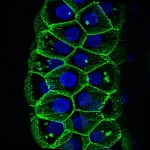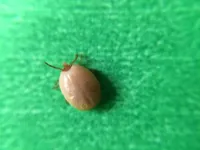(Press-News.org) There is growing evidence that consuming prebiotics — certain types of fiber often found in plants that stimulate beneficial bacteria in your gut — can help to maintain a healthy gut microbiome. In a new study, scientists estimated the prebiotic content of thousands of food types by using preexisting literature to find out which foods offer the highest prebiotic content.
According to the study, foods that pack the greatest prebiotic punch are dandelion greens, Jerusalem artichokes, garlic, leeks, and onions. In addition to supporting gut microbes, prebiotic rich foods contain high amounts of fiber — something most Americans do not get enough of.
“Eating prebiotic dense foods has been indicated by previous research to benefit health,” said Cassandra Boyd, a master’s student at San José State University who conducted the research with Assistant Professor John Gieng, PhD. “Eating in a way to promote microbiome wellness while eating more fiber may be more attainable and accessible than you think.”
Boyd will present the findings at NUTRITION 2023, the flagship annual meeting of the American Society for Nutrition held July 22–25 in Boston.
Prebiotics, which can be thought of as food for the microbiome, are different from probiotics, which contain live microorganisms. Both can potentially benefit microbiome health, but they work in different ways.
Studies have linked higher prebiotic intake with improved blood glucose regulation, better absorption of minerals like calcium, and markers of improved digestive and immune function. Although most dietary guidelines do not currently specify a recommended daily allowance for prebiotics, the International Scientific Association for Probiotics and Prebiotics — a non-profit scientific organization that established the currently held definition of prebiotics — recommends an intake of 5 grams per day.
For the study, researchers used previously published scientific findings to analyze the prebiotic content of 8,690 foods contained in the Food and Nutrient Database for Dietary Studies, a resource many scientists use to study nutrition and health.
About 37% of the foods in the database were found to contain prebiotics. Dandelion greens, Jerusalem artichoke, garlic, leeks, and onions had the greatest amounts, ranging from about 100-240 milligrams of prebiotics per gram of food (mg/g). Other prebiotic rich foods included onion rings, creamed onions, cowpeas, asparagus, and Kellogg's All-Bran cereal, each containing around 50-60 mg/g.
“The findings from our preliminary literature review suggest that onions and related foods contain multiple forms of prebiotics, leading to a larger total prebiotic content,” said Boyd. “Multiple forms of onions and related foods appear in a variety of dishes as both flavoring and main ingredients. These foods are commonly consumed by Americans and thus would be a feasible target for people to increase their prebiotic consumption.”
Based on the team’s findings, Boyd said a person would need to consume approximately half of a small (4-ounce) onion to get 5 grams of prebiotics.
Wheat-containing items rank lower on the list. Foods with little or no prebiotic content include dairy products, eggs, oils, and meats.
The researchers hope the study will provide a basis to help other scientists assess the health impacts of prebiotics and inform future dietary guidelines. They noted that more research is needed to understand how cooking impacts prebiotic content and to better assess foods that contain multiple ingredients.
Boyd will present this research at noon EDT on Saturday, July 22, during the Food Science and Nutrition Poster Session in the Hynes Convention Center Hall C (abstract; presentation details).
Please note that abstracts presented at NUTRITION 2023 were evaluated and selected by a committee of experts but have not generally undergone the same peer review process required for publication in a scientific journal. As such, the findings presented should be considered preliminary until a peer-reviewed publication is available.
About NUTRITION 2023
NUTRITION 2023 is the flagship meeting of the American Society for Nutrition and the premier educational event for nutritional professionals around the globe. NUTRITION brings together lab scientists, practicing clinicians, population health researchers, and community intervention investigators to identify solutions to today’s greatest nutrition challenges. Our audience also includes rising leaders in the field – undergraduate, graduate, and medical students. NUTRITION 2023 will be held July 22-25, 2023 in Boston. https://nutrition.org/N23 #Nutrition2023
About the American Society for Nutrition (ASN)
ASN is the preeminent professional organization for nutrition research scientists and clinicians around the world. Founded in 1928, the society brings together the top nutrition researchers, medical practitioners, policy makers and industry leaders to advance our knowledge and application of nutrition. ASN publishes four peer-reviewed journals and provides education and professional development opportunities to advance nutrition research, practice, and education. Since 2018, the American Society of Nutrition has presented NUTRITION, the leading global annual meeting for nutrition professionals. http://www.nutrition.org
Find more news briefs from NUTRITION 2023 at: https://www.eurekalert.org/newsroom/nutrition2023.
###
END
A University of Texas at Arlington engineering researcher is working on defenses that could thwart cyberattacks against networks of self-driving cars and unmanned aerial vehicles.
Animesh Chakravarthy, associate professor in the Department of Mechanical and Aerospace Engineering (MAE), is the principal investigator on an approximately $800,000 U.S. Department of Defense grant titled “Resilient Multi-Vehicle Networks.” MAE Professor Kamesh Subbarao, and Bill Beksi, assistant professor ...
Using electrochemistry to separate different particles within a solution (also known as electrochemical separation) is an energy-efficient strategy for environmental and water remediation: the process of purifying contaminated water. But while electrochemistry uses less energy than other, similar methods, the electric energy is largely derived from nonrenewable sources like fossil fuels.
Chemists at the University of Illinois Urbana-Champaign have demonstrated that water remediation can be powered in part — and ...
Millions of deaths and ongoing illnesses caused by the COVID-19 pandemic have prompted scientists to seek new ways of understanding how viruses so skillfully enter and reprogram human cells. Urgent innovations leading to the development of new therapies are needed since virologists predict that future deadly viruses and pandemics may again emerge from the coronavirus family.
One approach to developing new treatments for such coronaviruses, including the SARS-CoV-2 virus that causes COVID-19, is to block the mechanisms by which the virus reprograms our cells and forces them to produce more viral particles. But studies have identified nearly 1,000 human proteins ...
The worms that cause schistosomiasis (Schistosoma mansoni) are unusual in several ways, especially the fact that male and female adults must stay paired together throughout their lives for reproduction to be successful. Females may produce as many as 3,000 eggs per day. Approximately half reach the host’s gut or bladder. The rest are swept away via the blood to the liver and spleen, where they cause severe inflammation and liver cirrhosis, the main cause of mortality.
Researchers at Butantan Institute ...
Researchers have identified a number of chokepoints in U.S. agricultural and food supply chains through a study that improves our understanding of agri-food supply chain security and may aid policies aimed at enhancing its resilience. The work is presented in a paper published in the July 20, 2023, issue of the journal Nature Food, “Structural chokepoints determine the resilience of agri-food supply chains in the United States,” by authors including CEE Associate Professor Megan Konar and CEE Ph.D. student Deniz Berfin Karakoc.
The agricultural and food ...
The Spallation Neutron Source at the Department of Energy's Oak Ridge National Laboratory set a world record when its particle accelerator beam operating power reached 1.7 megawatts, substantially improving on the facility’s original design capability.
The accelerator’s higher power provides more neutrons for researchers who use the facility to study and improve a wide range of materials for more efficient solar panels, longer–lasting batteries and stronger, lighter materials for transportation. The achievement marks a new operational milestone for ...
The National Institute of Allergy and Infectious Diseases (NIAID), part of the National Institutes of Health, has awarded five projects for research to better understand Post-treatment Lyme Disease Syndrome (PTLDS), which is a collection of symptoms, such as pain, fatigue, and difficulty thinking or “brain fog,” which linger following standard treatment for Lyme disease. The Centers for Disease Control and Prevention estimates that 476,000 people in the United States are infected with Lyme disease each year. Between 10 and 20% of ...
WASHINGTON—The Endocrine Society opposes severe funding cuts proposed in the House Labor, Health and Human Services, Education, and Related Agencies (Labor-HHS) funding bill that would put life-saving endocrine research, disease prevention, and treatment at risk.
The House Appropriations Committee is planning to mark up the Labor-HHS funding bill before Congress leaves for its August recess.
The proposed funding levels in the Labor-HHS bill would harm America’s public health infrastructure and restrict research investments needed to develop next-generation cures. Cutting funding will reduce or eliminate services ...
ROCHESTER, Minn. — In a pilot study of 165 people, Mayo Clinic researchers looked at the effectiveness of two different approaches to weight loss: a standard lifestyle intervention and individualized therapy. The standard lifestyle intervention included a reduced diet, exercise and behavior therapy. The individualized approach was based on phenotypes and included different interventions depending on the person's predominant underlying cause of obesity. A diet based on phenotypes considers a person's ...
In just three years, millions of people across Michigan’s two huge peninsulas have taken advantage of their newfound ability to connect with their doctors, nurses and therapists through a computer or phone, a new report shows.
Between 11% and 17% of all appointments to evaluate symptoms or discuss treatment now take place virtually, depending on the type of insurance, the analysis shows.
That’s up from less than 1% of such visits before the COVID-19 pandemic suddenly spurred temporary flexibility in health insurance rules for telehealth, according to the report by a team from the University of Michigan Institute for Healthcare ...





